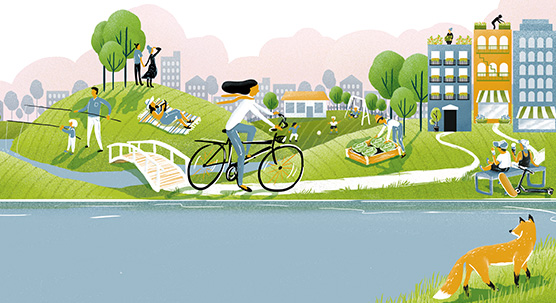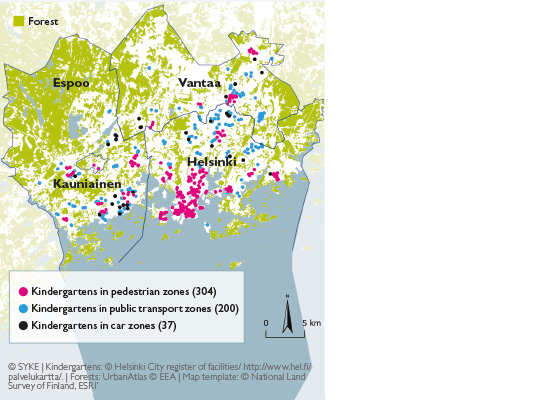Press release 2017-08-24 at 12:51

© Marianna Korpi/ SYKE
The health and well-being impacts of contacts with nature are increasingly being discussed in relation to environmental policies in Finland and around Europe. Access to nature is important even in densely populated residential districts. Such benefits can best be realised through coherent planning. The latest policy brief published by the Finnish Environment Institute (SYKE) lists important factors for planners to consider.
“Planners need to enter into purposeful dialogues, involving as wide a range of stakeholders as possible – including the people who actually use urban nature and public transport developers as well as planners and architects,” explains Riikka Paloniemi, who heads SYKE’s Green Infrastructure Unit.
To promote effective participatory planning it is important that the health benefits of local natural areas should be more widely recognised, and considered in planning procedures from the regional level right down to the very local level. Responsibility for planning green areas in urban settings should also be allocated more clearly. The varying characteristics of different types of urban districts must always be duly considered in planning, since needs and opportunities in relation to urban nature are quite different in central districts and more suburban locations.
Access to nature particularly important for children
“Areas of forest, parks and other elements of urban nature should especially be accessible near kindergartens and primary schools,” adds Paloniemi. “Ideally, their use can then be deeply integrated into routines and educational syllabuses.”
Opportunities for more than 1,000 kindergartens in the Helsinki Metropolitan Area to enjoy recreational activities in local green areas have been assessed by SYKE, using GIS data. Planning guidelines issued by Finland’s Ministry of the Environment recommend that natural areas suitable for recreational activities should be accessible within 300 metres of all residential areas. The study’s findings showed that more than half of the kindergartens were located more than 300 metres from the nearest area of forest, but that more formal parks served a valuable complementary role to forest areas in the overall network of urban recreational areas. Only about 20 kindergartens were located more than 300 metres from the nearest park or area of forest.
In natural settings children are beneficially exposed to microbes, strengthening their immune systems. Reduced exposure to natural microbes impoverishes the microbiota in their bodies, thereby reducing their resistance. This in turn leads to problems such as inflammatory conditions and atopic sensitisation, reflected in the prevalence of conditions such as allergies and asthma. Research findings support a theory known as “the biodiversity hypothesis”, by showing, for example, that the distances between the homes of small children and the nearest area of forest or farmland are reflected in levels of atopic sensitisation.

Kindergartens located more than 300 metres from the nearest
forest, in different urban zones in the Helsinki Metropolitan Area.
© SYKE
SYKE’s latest State of the Environment report examines urban nature in Finland
In addition to the new Policy Brief, SYKE has published a State of the Environment report focusing on urban nature. Most people in Finland today live in densely populated settlements, and the popularity of urban living is increasing. A 2016 survey of Finnish urban residents indicated that the most important factors affecting their satisfaction are a good location and transport connections, but the presence of natural environments nearby was rated as the next most important factor.
The report compiles data on the total extents of urban area and trends in population density, while also examining how the spread of urban development has affected nearby natural areas including forests. Surveys indicate that the populations of birds associated with urban environments and other cultural habitats have increased. The built environment is today the only habitat type where the trend for species to become more threatened has been halted.
During 2017, to mark the centenary of Finland’s independence, SYKE is publishing four info packages looking at the state of the environment around the country today and in the future. The first and second packages, examining water protection and the circular economy, were published in March and June. A fourth review, focusing on climate change, will appear in November.
Publications
More information
- Policy Brief
Riikka Paloniemi, head of Green Infrastructure Unit,
Finnish Environment Institute (SYKE)
tel +358 295 251 493, firstname.surname@ymparisto.fi
- State of the Environment report
Maija Tiitu, researcher specialising in spatial structure and urban form,
Finnish Environment Institute (SYKE)
tel +358 295 251 695, firstname.surname@ymparisto.fi
- Communications
Leena Rantajärvi, communications specialist,
Finnish Environment Institute (SYKE)
tel: +358 295 251 543, firstname.surname@ymparisto.fi